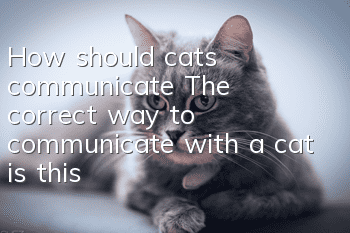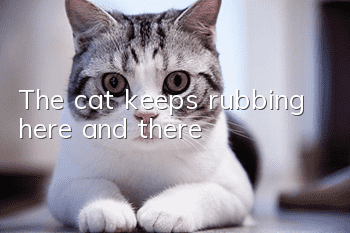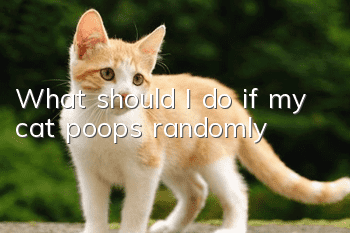How should cats communicate? The correct way to communicate with a cat is this

Compared with dogs and cats, it is easier for humans to understand the emotions and behaviors of dogs, because dogs and humans have a close relationship, and dogs are also very clingy and easy to tame. Cats, on the other hand, are aloof and often ignore their owners' calls. There are also many owners who do not know how to communicate with cats. Although cats are more difficult to tame than dogs, you can still communicate with cats as long as you use the right method.
New research results show that it is possible to communicate with felines - even if it is not the cat's intention.
What do cats do at home every day? Secretly drink the water from your cup? Scratch your sofa? Wait for the meal to be served? Take a good nap after eating?
People have spent many years trying to figure out what cats want to say to us: studying their meows, whines, purrs, smacks, and that most mysterious of all, their purrs; in addition, their rich What does body language mean?
The most fundamental problem that these studies cannot resolve is that cats just don’t speak. But don’t panic, new research shows that communicating with cats is still useful.
Communication between cats, except between mother cat and kitten, is almost entirely non-verbal, relying only on body language and smell. Human communication basically relies on spoken language, tones and facial expressions - the problem comes again, cats have almost no facial muscles compared to dogs and their owners.
Mikel Maria Delgado, who studies human and pet behavior, especially cat behavior, and is the most authoritative research expert in the United States, believes that cats actually collect information from our facial expressions. A lot of information. She notes that many studies, including the latest one last year, have examined whether cats can understand human emotions through human facial expressions. Although the results of these studies are not conclusive, they do point the way to our understanding of each other.
"Research shows that cats do have different reactions when their owners show joy or anger," she said (the owner's role is very important, and cats don't seem to care at all about strong emotions displayed by strangers). fluctuation).
These simple emotions allow cats to learn human expressions by following some very basic association patterns; basically, all cats care about are the emotions you make that have a predictable impact on them. And their responses to these emotions may be unconscious. "
When people are in very intense, hesitant or nervous moods, they are actually sending out messages, either through their bodies, through their voices, or even through smells, such as sweat produced under stress."I think animals can detect these changes and capture this information," Delgado said. ”
The classic case of cats rushing to the sound of an electric can opener is for the same reason: they know the sound means there is food. Can cats understand the relationship between can openers and food production? I’m afraid not.
But we can still send messages to cats through similar methods: making angry or happy expressions is also a form of communication. So, when you yelled: "Get away! Stay away from the cabinet!", the cat didn't understand what every word you said meant, but it knew that it had done something it shouldn't have done.
In addition to the emotions conveyed by the face, we can try to have some more subtle communication with the cat. Bradshaw thinks there are some other ways we can communicate like this. For example, learn the behaviors of cats and imitate them; or, train a cat like a dog.
The former is a little more difficult. First of all, it is useless to meow like a cat. "I don't recommend that people meow at their cats," Bradshaw said. "In fact, people do like to meow at their cats, and while it's harmless, I don't think it's harmful to them. What effect does a cat have."
In fact, meows are almost never heard in wild cat colonies. Meows are just a trick used by cats to attract human attention. They meow because we respond to the sound, not because they themselves respond to the sound.
A great technique to use is the "slow blink," a technique that TV host Jackson Galaxy is very fond of. The rationale behind the idea is that unlike humans, where staring can irritate cats, blinking can dilute the irritation. Both Bradshaw and Delgado mention this technique, but there is not enough research to support it. “But I don’t think it’s a bad idea,” Delgado said.
So, can you communicate with a cat through explicit training?
Both Delgado and Bradshaw agree that it's definitely doable, but it's not as easy as training a dog. Despite cats' reputation as being difficult to train, they are actually completely trainable.
"It's actually pretty easy to teach a cat to sit," Delgado said with a laugh. "If you want to train them to do something they usually do, then it only takes a little effort." You can teach it almost the same way as training a dog.The cat will respond to some words (such as "sit", "high five", etc.). The difference, adds Bradshaw, is that food is not the best reward for tame cats. Caressing or rewarding your pet with a favorite toy may be more effective.
However, because cats have extremely short attention spans, a lengthy training process may be unacceptable to them. "You have to know when they're most willing to be trained, because probably 90 percent of the time they won't cooperate," Bradshaw said. Even with a 10% chance, it's hard to ask a cat to pay attention for more than a few minutes.
Cats can associate words with actions just like dogs, but Bradshaw thinks they may respond better to actions than words. So the best way to train your cat to give high fives is to raise your hands and say "High five" to it.
- Cat conjunctivitis symptoms and treatments
- Why does cat plague appear after taking deworming medicine? Maybe it is already in the incubation period!
- Why do kittens snore?
- What causes blood in American shorthair cats' poop?
- Why does a cat have blue eyes and yellow eyes?
- How to raise Bombay cats
- How many colors do fold-eared cats have?
- Can Acerra cats be kept in China?
- Can I spank a cat if it disobeys?
- Why does a cat open its mouth and pant?



